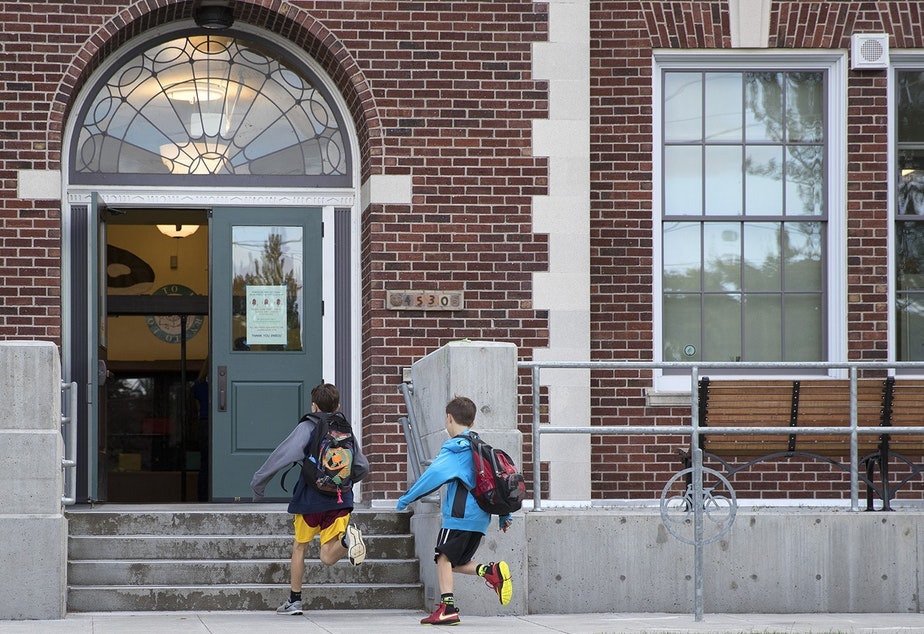Why so many snow days? And how will schools make them up?

Kim Malcolm talks with KUOW education reporter Ann Dornfeld about how Seattle Public Schools decides to suspend operations due to weather, and what options the district has for making up for snow days.
KIM MALCOLM: So you talked with Seattle Public Schools today. What did they tell you about what they take into consideration when they close school?
ANN DORNFELD: Well, a lot of parents have been frustrated that the roads that they've driven have been fine... So why, oh why, is school still closed?
I talked with Deputy Superintendent Stephen Nielsen. He said that there are a lot of factors that go into the decision to cancel classes, including some that parents might not consider - like the large number of students who walk to school, many of whom have no other way to get there besides foot. They may not have the best snowy-weather foot-gear, and a lot of sidewalks are still super-slushy. Stepping off the curb can land you up to your shins in icy water.
STEPHEN NIELSEN: "I was driving to work this morning through my neighborhood, and I saw people walking down the middle of the street because the sidewalks were still very slippery and slushy. And then you take the risk of walking down the main road that's been plowed - which is great for walking - and terrible before it gets light, and people can get hit."
DORNFELD: Nielsen also said that around schools - on the sidewalks around schools, in the parking lot, the paths to schools - can still be in bad shape, and hard to get there.
Sponsored
And the city has all these micro-climates, so even if your neighborhood is looking good, the other side of town might not be.
He also said the cost of living in Seattle is so high that a lot of staff members - teachers, bus drivers - can't afford to live in the city. So if things aren't good where they live, that can make it very hard for them to get to work and do their jobs.
MALCOLM: And you have also been reporting on how the school closures are affecting families. What have you learned so far?
DORNFELD: Well, parents are having to get very creative - either with working from home while their children are in their midst, or finding backup childcare when everyone wants backup childcare and the child care providers can't necessarily get around. So that's been hard for a lot of parents, and for low-income families it's even more challenging, because on top of the childcare scramble they might need to pay double for the childcare they already paid for for younger children.
In addition to secondary childcare, they might have to miss days from work because their work might be closed, or they might have to stay home with the children.
Sponsored
They might be missing out on free breakfast and lunch, because school covers breakfast and lunch for low-income families.
MALCOLM: Now, I understand Bellingham schools are closed for school today, but they are also offering free meals for students and families. Is this happening in Seattle or other districts nearby?
DORNFELD: It's not happening in Seattle or any other districts that I heard of but that would be a welcome addition for many families now. Update: Northshore School District is also offering free meals for students when school is closed due to inclement weather.
MALCOLM: Well, snow days do have to get made up in Washington state. Students are required by law to have over 1000 hours of class time each year. So what are the options for make-up days?
DORNFELD: Districts vary in terms of how many snow make-up days they already have built into their calendars. In Seattle, we only have two available at this point in the year - at the end of the school year - so the options include adding on more days to those, or changing teacher in-service days to school days.
Sponsored
MALCOLM: Has Seattle Public Schools indicated what they might do at this point?
DORNFELD: The deputy superintendent told me that the district hasn't started figuring that out. They want to wait until the potential for winter weather is behind us. So it could be a month or more before families know how the school year is going to change. For those of us who grew up in Seattle in the 1980s, there was a 19-day teachers strike in 1985, followed by a snowstorm two months later, and we went to school into July.
MALCOLM: Washington's Superintendent of Public Instruction Chris Reykdal says schools can apply to waive those missed school days. What does that mean, exactly?
DORNFELD: It's kind of complicated. State law requires that K-12 schools be in session for 180 days, but extenuating circumstances like this kind of snow event can make it possible for districts to apply for waivers from that 180-day requirement.
I spoke to a bunch of districts that all expressed interest in applying for waivers, but none had done so yet. They all seem to be crunching the numbers to see how many days they could feasibly get waived, because no matter what, the state requires that districts offer an average of 1,027 hours of instruction each year.
Sponsored
So there are a lot of spreadsheets open at district headquarters across our region today.






